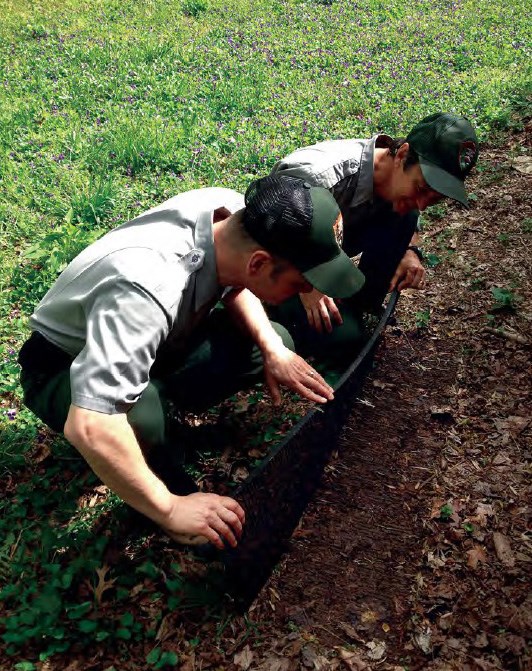Last updated: July 21, 2020
Article
Citizen Science and Entomology
Citizen science is when members of the public participate in the scientific process through collaboration with scientists and organizations. This is one case study demonstrating the value of citizen science in helping the National Park Service to meet its mission.
Case Study Overview
The level of biodiversity along the George Washington Memorial Parkway (GWMP) is astounding. Over the past 13 years, citizen science projects were conducted at various sites along the parkway to create a biological inventory and assess the impact human-caused soil disturbances have upon populations. One of these projects focused on documenting beetle species.

Project Description
Citizen scientists worked at the Turkey Run Park, Great Falls Park and Dyke Marsh Wildlife Preserve areas of the Parkway. Various trapping methods were utilized, including Malaise, Lindgren funnel, and pan traps, black-light, beating sheets, and sporadic collecting by hand. Collection could take place over a period of days or weeks. Periods of adult activity, based on dates of capture, are given for each species. Relative abundance is noted for each species based on the number of captures. Notes on morphological characteristics and habitats are given for some species.
In the lab, NPS scientists trained volunteers to sort and prepare beetle specimens according to museum standards. Thirty Arlington Regional Master Naturalist (ARMN) volunteers have prepared approximately 12,000 specimens in the NPS-built "Bug Lab" for the park reference collection. Collected species are compared with specimen from the Smithsonian Institution National Museum of Natural History, the Virginia Museum of Natural History, the Illinois Natural History Survey, and the Louisiana State Arthropod Museum.
As of 2018, over 1,000 species of beetles have been documented. Experts were able to identify 754 different beetle species, more than half of which had never before been recorded in the Parkway. Twenty species were reported as new records for Virginia. The project also produced digital photographs and contributed data to the list of the 100 most common beetle species in the Parkway. Volunteers further contributed their efforts to a 2010 “Beetlemania” workshop and 2011 brown bag seminar, both of which were open to the public.
Challenges
Training in beetle identification and museum practices were a challenge for the project.
As a part of their work at the GWMP, citizen scientists received training applicable to both the specific beetle specimen project, but also in museum-standard practices more broadly.
Benefits and Outcomes
The entomology project at GWMP demonstrated that there is still a tremendous amount of biological diversity to be discovered on the GWMP, and that citizen scientists can help reveal it. The project may result in significant changes to maintenance best management practices service-wide. In addition, the volunteers' assistance has significantly reduced the backlog of beetle by-catch samples collected by National Museum of Natural History and Georgetown University projects.
The many publications, presentations, and public outreach efforts that resulted from the project reveals just how impactful the work of citizen scientists can be on NPS projects that both uphold the mission of the parks, and advance scientific knowledge.
Tips
The GWMP Entomology Project case study illustrates the following steps in the Federal Citizen Science and Crowdsourcing Toolkit:
- Manage Your Data—Acquire Your Data: Multiple field collection methods were implemented. Collection time periods varied from a day to multiple weeks when utilizing traps.
- Manage Your Data—Process Your Data: This project utilized data collected in the field alongside existing museum collections and reference materials. All data was processed in the same manner to allow simple comparison.
- Manage Your Data—Analyze Your Data: By synthesizing beetle population data, the project brought many new species to light and increased the amount of known biodiversity along the parkway. In addition, the project also documented volunteer hours to monitor project effectiveness.
Contact Information
Visit the GWMP Science & Research webpage for more information or contact Natural Resources Manager Brent Steury at brent_steury@nps.gov
